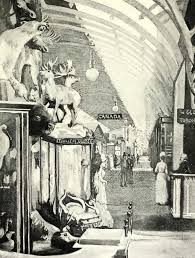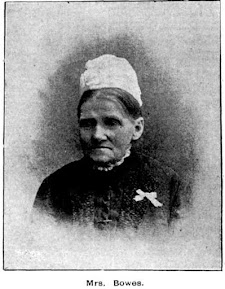A talented woman making it big in a man's world
A female who was the first professional woman employed by an Australian Museum and arguably the best in her field is lying under a headstone that doesn't bear her name. Forgotten no more..
JANE CATHERINE TOST
Jane was born in 1817 (believed to be in London England) to John Ward, a bird breeder, and his wife, Catherine. Her parents not only bred birds but also stuffed them for gentlemen collectors and had been carrying out this activity since the early 1800's. Jane and her siblings learnt the trade first hand and later the siblings were working in the Gould's taxidermy shop in London.
On 1 April 1839, Jane married Charles Gottleibe Tost, a native of Prussia and a piano-forte maker; they were to go on to have six children. The workload at Gould's became so large that Jane was taken on in a greater role and during the 1840's -1850's under Gould's direction she was employed at the British Museum, preparing specimens.
Although taxidermy had been practised from the mid 1700's it's golden age was during the Victorian era when mounted animals became a popular part of interior decor.
Many displays were on view at the Great Exhibition of 1851 in London and generated much interest from the public and scientists. Displays of birds were quite common in Victoria homes; Queen Victoria had a large personal collection, and taxidermists became extremely busy performing their skills upon dead pets for bereaved owners.
Taxidermy exhibits in Victorian age-historytoday.com with thanks
Jane, her husband Charles and their children sailed from Liverpool England and reached Tasmania in January 1856, where Jane took up a position stuffing and mounting specimens for the Royal Society of Tasmania at the Hobart Town Museum. The family moved to Sydney in 1860, Jane offering her services as a naturalist from the family home in Bridge Street. In 1864 she became taxidermist at the Australian Museum, earning £10 a month, the same wage as her male counterparts: she was one of Australia's earliest professional female museum staff members. Her employment ended in 1869 when her husband, who also worked at the museum as a taxidermist and carpenter, clashed with the curator Gerard Krefft. An inquiry found that Krefft, who was later dismissed, had attempted to frame Charles for theft by depositing museum property at the Tosts' home.
Taxidermy exhibit, Australian Museum Sydney with thanks
It seems that Charles left for England soon after having taken the accusations to heart. Jane ceased full-time employment after the incident, and although the museum refused her requests to be reinstated in the years that followed, it continued to purchase specimens from her during the 1870’s and thereby keeping the Museum supplied with collection items for the next fifty years.
Jane Tost's work in Australian Museum Sydney - untoldstories.net with thanks
Jane and Charle's third child, Ada, had a successful stage career in Sydney and in October 1868 she married James Richardson Coates, a dealer in earthenware, glass and china. They had three children.
In 1872 Ada's husband James, and her brother, Charles (Jnr), were killed fighting a fire at the Prince of Wales Theatre in Sydney. The fire was believed to have started in the property room and within a short space of time had spread to the surrounding premises. Fire engines hastened to the scene but due to the fire's ferocity they were rendered incapable of much assistance. Many people rushed to help extinguish the flames including Charles and James but both succumbed to smoke and injuries. (The full story will be disclosed in a future blog).
Money received from a benefit fund allowed for Jane and Ada to open 'Tost & Coates Berlin Wool Depot and Taxidermists' at 60 William Street, which catered to a growing middle-class taste for fancy work and stuffed animals in interior decoration, as well as to scientific collectors and museums. They also offered lessons in taxidermy and fancy work as it was fast becoming a leisure activity for middle and upper-class women of the time.
Ada remarried in 1878 to Henry Stewart Bovenure Rohu, a Scottish-born upholsterer and curio collector and the firm became 'Tost & Rohu'. They went on to have six children. The business grew, selling furs, stuffed animals and Aboriginal and Islander artefacts.
Advertisement - untoldstories.net with thanks
Ever the entrepreneurs Jane and Ada promoted their business by exhibiting selected works at international exhibitions and between 1860 and 1900, they won twenty medals between them.
Jane Tost died on 24 April 1889, and was buried in the Church of England section of Rookwood, her husband Charles having also died in 1872 whilst overseas. She lies beneath the headstone erected by her daughter, Caroline Jane but is not mentioned. Two sons and a daughter survived her.
Jane Tost grave - headstone only mentions her son - findagrave with thanks
Ada carried on the business which in 1896 moved to larger premises in Martin Place. The shop had expanded to take on more unusual stock such as native armour, spears, dresses, ancient muskets, tiger skins, birds' feather and stuffed animals.
Ada died on 28 July 1928 at Newtown and was buried in Rookwood cemetery in a different section to her mother and brother, Henry having died in 1921. Two sons and one daughter of her first marriage, and four daughters and a son of her second, survived her. James Tyrell took over the shop and added a museum to it before reverting solely to bookselling.
Another example of a woman forging into a profession dominated by men (and receiving the same monetary wage) but soon attracting the female of the species.
I will certainly be looking at taxidermy in a new light when I next visit the Australian Museum!
Feel free to add a comment to this blog or comment at the Facebook group page by searching for rookwoodcemeterydiscoveries where I will respond to any queries as soon as possible








Very interesting Loraine, thank you.
ReplyDeleteThanks Brett - what a brilliant person!
DeleteWhat an amazing woman!
ReplyDeleteAbsolutely!
Delete